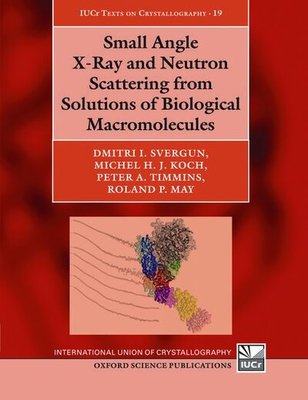
Small angle x-ray and neutron scattering from solutions of biological macromolecules - D. I Svergun

Small angle x-ray and neutron scattering from solutions of biological macromolecules
D. I Svergun
Paperback / softback
Oxford University Press
English
20200106
Small-angle scattering of X-rays (SAXS) and neutrons (SANS) is an established method for the structural characterization of biological objects in a broad size range from individual macromolecules (proteins, nucleic acids, lipids) to large macromolecular complexes. SAXS/SANS is complementary to the high resolution methods of X-ray crystallography and nuclear magnetic resonance, allowing for hybrid modeling and also accounting for available biophysical and biochemicaldata. Quantitative characterization of flexible macromolecular systems and mixtures has recently become possible. SAXS/SANS measurements can be easily performed in different conditions by adding ligands or binding partners, and by changing physical and/or chemical characteristics of the solvent toprovide information on the structural responses. The technique provides kinetic information about processes like folding and assembly and also allows one to analyze macromolecular interactions. The major factors promoting the increasingly active use of SAXS/SANS are modern high brilliance X-ray and neutron sources, novel data analysis methods, and automation of the experiment, data processing and interpretation.In this book, following the presentation of the basics of scattering from isotropic macromolecular solutions, modern instrumentation, experimental practice and advanced analysis techniques are explained.
Advantages of X-rays (rapid data collection, small sample volumes) and of neutrons (contrast variation by hydrogen/deuterium exchange) are specifically highlighted. Examples of applications of the technique to different macromolecular systems are considered with specific emphasis on thesynergistic use of SAXS/SANS with other structural, biophysical and computational techniques.
We are Rated Excellent on Trustpilot
Here's what you say about us...
We are Rated Excellent on Trustpilot
Here's what you say about us...
Dmitri I.Svergun: MSc in Solid state physics (1980), Physics Department, Moscow State University, Russia; PhD in Physics and Mathematics (1982) and Dr. of Science (1997), Institute of Crystallography, Moscow, Russia; Engineer, Researcher, Senior Scientist at the Institute of Crystallography, Russian Academy of Sciences, Moscow (1980 - 2008); Guest scientist, GKSS Research Centre, Geesthacht, Germany (1990-1991); Visitor, Staff Scientist, Group Leader, at the European
Molecular Biology Laboratory Hamburg Outstation (1991-present).
Michel, H.J. Koch: PhD in chemistry, University of Louvain (1970), Neutron scattering on biological macromolecules in solution (1974-1976). Consultant (1975-1976), Group leader at the European Molecular Biology Laboratory outstation at DESY, Hamburg (1977-2006), Visiting professor at the Faculty of Engineering and Natural Science, Sabanci University, Turkey (2008-2009) and the Chemistry Department, University of Leuven (2006 - present).
Roland May: Diploma in Physics (Technische Universitt Mnchen); Thesis work at the Max-Planck Institut fr Biochemie, Martinsried; PhD Technische Universitt Mnchen 1978; scientist in the Large-Scale Structures group of the Institut Laue-Langevin, Grenoble until 2008; retired.
Peter Timmins: BSc in Chemistry (1967), MSc in Crystallography (1968) and PhD in Crystallography (1972) - Birkbeck College, University of London. Instrument Scientist, Institut Laue-Langevin, 1975 - 1993, Head, Large Scale Structures Group, Institut Laue-Langevin, 1993 - 2010. Since 2010, retired.
This book is a masterly treatment by four authors with many decades of experience of SAXS and SANS and who are from world class synchrotron X-ray and neutron research facilities. From the basics and on through the instrumentation and data analysis descriptions, as well as numerous research themes and examples, this book will be invaluable to newcomers and be useful to the specialists. It also should be read in detail by structural biology researchers whether
principally from crystallography, bio NMR, EM or bioinformatics. It's surely going to be a classic book.
John Helliwell, University of Manchester
Small angle X-ray and neutron scattering from solutions of biological macromolecules is an essential book covering the theory, experiment, data analysis, and applications of small-angle scattering (SAS) ... No laboratory interested in SAS should be without a copy and it provides a good background to the capabilities, limitations, and practical application of the technique. The authors should be commended and the book is strongly recommended.
Crystallography Reviews












